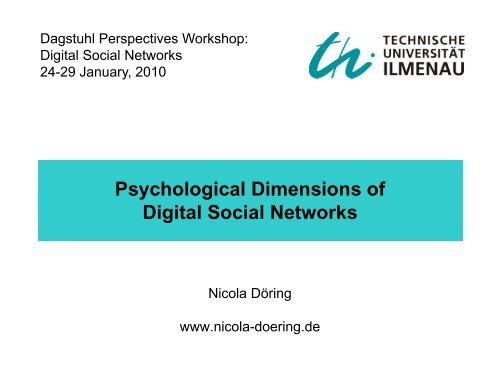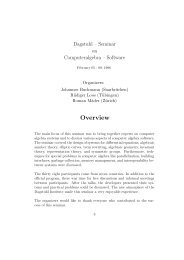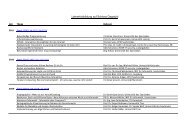Relationship Management
Relationship Management
Relationship Management
You also want an ePaper? Increase the reach of your titles
YUMPU automatically turns print PDFs into web optimized ePapers that Google loves.
Dagstuhl Perspectives Workshop:<br />
Digital Social Networks<br />
24-29 January, 2010<br />
Psychological Dimensions of<br />
Digital Social Networks<br />
Nicola Döring<br />
www.nicola-doering.de
Ilmenau University of Technology<br />
Institut für Medien und Kommunikationswissenschaft<br />
www.ifmk.de<br />
Media Design / Media Psychology
Internet Psychology<br />
Research Object<br />
- online (& offline) behaviors and experiences<br />
- of individual internet users (and groups)<br />
- embedded in social contexts<br />
Research Perspective<br />
• Rejection of Media/Technology Determinism<br />
(„what media/technologies do to people“)<br />
• Affirmation of Active Audiences / Active Media Users<br />
(„what people do with media/technologies“)<br />
Theories of Action
Internet Psychology<br />
Basic Research<br />
- Understanding/explaining online behaviors and<br />
experiences by developing new psychological theories<br />
- Online behaviors and experiences as testbed<br />
for established psychological theories<br />
Applied Research<br />
• Psychological input for fostering media literacy<br />
(reducing digital inequalities)<br />
• Psychological input for critical analysis of public discourses<br />
about media innovations<br />
• Psychological input for human-centered media development
Research Methods in<br />
Internet Psychology<br />
Offline Data Collection<br />
(quantitative & qualitative)<br />
Online Data Collection<br />
(quantitative & qualitative)<br />
Non-Experimental<br />
Studies:<br />
- Survey Paper Questionnaire Online Questionnaire<br />
- Interview Oral Interviews<br />
Focus Groups<br />
- Observation Observation in Offline<br />
Contexts<br />
- Document Analysis Analysis of Offline<br />
Documents<br />
Experimental<br />
Study<br />
Case<br />
Study<br />
Online Interviews<br />
Field Observation in Online<br />
Contexts<br />
Analysis of Online<br />
Documents<br />
Laboratory Experiment Online Experiment<br />
Extensive Offline and/or Online Data Collection<br />
5
Population-Representative Surveys of Online Behavior<br />
Germany:<br />
- ARD/ZDF-Online-Studie ARD/ZDF<br />
- KIM-Studie Medienpädagogischer Forschungsverbund Südwest<br />
- JIM-Studie Medienpädagogischer Forschungsverbund Südwest<br />
USA:<br />
- PEW Internet & American Life<br />
6
Weekly Web 2.0-Use in % (14 to 29 years old)<br />
ARD/ZDF-Onlinestudie 2009<br />
Professional SNS<br />
SNS<br />
7
SNS Usage by University Students 2010 (1st Semester)<br />
23,1<br />
Frequency of usage in percent (N=114)<br />
9,1<br />
3,2<br />
58,7<br />
several times a day<br />
once a day<br />
several times a week<br />
more seldom<br />
9
oyd, d. m., & Ellison, N. B. (2007).<br />
Social network sites: Definition, history, and scholarship.<br />
Journal of Computer-Mediated Communication, 13(1), article 11.<br />
http://jcmc.indiana.edu/vol13/issue1/boyd.ellison.html<br />
Definition:<br />
We define social network sites as web-based services that<br />
allow individuals to<br />
(1) construct a public or semi-public profile within a bounded<br />
system,<br />
(2) articulate a list of other users with whom they share a<br />
connection, and<br />
(3) view and traverse their list of connections and those<br />
made by others within the system.<br />
The nature and nomenclature of these connections may<br />
vary from site to site.
Identity <strong>Management</strong><br />
Online Profile<br />
Privacy Settings<br />
Use of Multiple Platforms<br />
Psychological Research on SNS<br />
<strong>Relationship</strong> <strong>Management</strong><br />
List of Friends<br />
Social Network Structure<br />
Interpersonal SNS Behavior
Identity <strong>Management</strong><br />
Self Presentation on SNS Profiles:<br />
a) mostly authentic demographic information (name, age, gender, location etc.)<br />
b) implicit rather than explicit identity claims („show rather than tell“)<br />
group and consumer identities (friends, tastes, fandom, brands etc.)<br />
c) both self-produced and re-used artefacts (status updates, photos, videos etc.)
Identity <strong>Management</strong><br />
Self Presentation on SNS Profiles:<br />
a) mostly authentic demographic information (name, age, gender, location etc.)<br />
b) implicit rather than explicit identity claims („show rather than tell“)<br />
group and consumer identities (friends, tastes, fandom, brands etc.)<br />
c) both self-produced and re-used artefacts (status updates, photos, videos etc.)<br />
Identity Work (self-directed implications of SNS self presentation)<br />
- reflection/affirmation of different aspects of self<br />
- opportunities of identity de-marginalization<br />
Impression Formation (other-directed implications of SNS self presentation)<br />
- successful/unsuccessful self presentation (e.g. attractive, likable, competent)<br />
- differences/similarities between online and offline impressions (e.g. personality)<br />
- privacy issues (privacy settings, multiple separated profiles,<br />
online-reputation management, expiration dates for digital documents)
New Yorker, 1997<br />
2009
<strong>Relationship</strong> <strong>Management</strong><br />
List of Friends:<br />
a) number of „SNS friends“<br />
b) relationship types („SNS friends“ ≠ friendship)<br />
c) social network structure
Number and types of StudiVZ friends<br />
(University Students 2010, 1st Semester)<br />
20
<strong>Relationship</strong> <strong>Management</strong><br />
List of Friends:<br />
a) number of „SNS friends“<br />
b) relationship types („SNS friends“ ≠ friendship)<br />
c) social network structure<br />
Social Integration and Social Capital<br />
- Maintained Social Capital (members of previously inhabited community)<br />
- Bridging Social Capital (weak ties)<br />
- Bonding Social Capital (strong ties)<br />
<strong>Relationship</strong> Formation, Maintenance, Termination<br />
- Interpersonal SNS Behavior<br />
- Social Norms regarding SNS friendship requests<br />
- Experience of Online Social Presence
Media Use in a Close „Real“ Friendship<br />
(University Students 2010, 1st Semester)<br />
23
Psychological Research on SNS<br />
Identity <strong>Management</strong> <strong>Relationship</strong> <strong>Management</strong><br />
Basic Research<br />
- Testing new and established psychological theories<br />
Different Empirical Research Methods<br />
Applied Research<br />
• Psychological input for fostering media literacy<br />
(reducing digital inequalities)<br />
• Psychological input for critical analysis of public<br />
discourses about media innovations<br />
• Psychological input for human-centered media<br />
development
References<br />
relevant journals:<br />
- Journal of Computer Mediated Communication JCMC<br />
- Computers in Human Behavior
Identity management through SNS<br />
boyd, d. (2004). Friendster and Publicly Articulated Social Networks. Conference on Human Factors and Computing Systems<br />
(CHI 2004). Vienna: ACM, April 24-29, 2004.<br />
boyd, d. (2007). Why Youth (Heart) Social Network Sites: The Role of Networked Publics in Teenage Social Life. In:<br />
Buckingham, David (2007): Youth, Identity, and Digital Media, Seite 119-142. Cambridge, MIT Press<br />
boyd, d. (2008). Taken Out of Context. American Teen Sociality in Networkes Publics. Dissertation zur Erlangung des Grades<br />
eines Doktors der Philosophie. Online im Internet: http://www.danah.org/papers/TakenOutOfContext.pdf<br />
boyd, d. & Ellison, N. (2007). "Social Network Sites: Definition, History, and Scholarship." Journal of Computer-Mediated<br />
Communication, 13 (1)<br />
Döring, N. (2003). Sozialpsychologie des Internet. Die Bedeutung des Internet für Kommunikationsprozesse, Identitäten,<br />
soziale Beziehungen und Gruppen. 2. Auflage. Göttingen, Hogrefe.<br />
Goffman, E. (2003). Wir alle spielen Theater. Selbstdarstellung im Alltag. München, Piper.<br />
Ito, M. et al. (2008). Living and Learning with New Media: Summary of Findings from the Digital Youth Project. The John D.<br />
and Catherine T. MacArthur Foundation Reports on Digital Media and Learning. Online im Internet:<br />
http://digitalyouth.ischool.berkeley.edu/report<br />
Mummendey, H. D. (1995). Psychologie der Selbstdarstellung. 2. Auflage. Göttingen, Hogrefe<br />
Prommer, E.; Brücks, A.; Mehnert, J.; Neumann, H.; Räder, A. & Roßland, F. (2009). „Real life extension“ in Web-basierten<br />
sozialen Netzwerken. Eine Studie zur Selbstrepräsentation von Studierenden in studiVZ. Forschungsbericht.<br />
http://www.hff-potsdam.de/fileadmin/hff/dokumente/aktuelles/Medienwiss_Forschungsbericht_studivz.pdf<br />
Skog, D. (2005). Social interaction in virtual communities: the significance of technology. International Journal of Web Based<br />
Communities 1(4) S. 464 – 474.<br />
Weiterführende Literatur unter:<br />
http://www.webnographers.org/index.php?title=Papers#Social_Networking_Sites_and_Older_People.27s_.2860.2B_yrs.29_Us<br />
e
<strong>Relationship</strong> <strong>Management</strong> through SNS<br />
Burt, R. S. (2000). The Network Structure of Social Capital. In: Research in Organizational Behavior, 22, Seite 345-423<br />
Coleman, J. (1988). Social Capital in the Creation of human Capital. In: American Journal of Sociology (AJS), 94, Seite S95-<br />
S120<br />
Donath, J. & boyd, D. (2004). Public displays of connection. BT Technology Journal, 22(4), 71.<br />
Ellison, N. B., Steinfield, C., & Lampe, C. (2007). The benefits of Facebook "friends:" Social capital and college students' use of<br />
online social network sites. Journal of Computer-Mediated Communication, 12(4), article 1.<br />
http://jcmc.indiana.edu/vol12/issue4/ellison.html<br />
Granovetter, M. S. (1973). The strength of weak ties. In: American Journal of Sociology (AJS), 78(6), Seite 1360-1380.<br />
Hampton, K. & Wellman. B. (2003). “Neighboring in Netville: How the Internet Supports Community and Social Capital in a Wired<br />
Suburb.” City and Community 3(2), 277-311<br />
Kavanaugh, A., Carroll, J. M., Rosson, M. B., Zin, T. T., and Reese, D. D. (2005). Community networks: Where offline<br />
communities meet online. Journal of Computer-Mediated Communication, 10(4). Online im Internet:<br />
http://jcmc.indiana.edu/vol10/issue4/kavanaugh.html<br />
Lin, N. (2001). Building a Network Theory of Social Capital. In: Lin, Nan; Cook, Karen & Burt, Ronald S. (Hrsg.): Social Capital.<br />
Theory and Research. New York, de Gruyter<br />
Lin, N.; Cook, K. & Burt, R. S. (Hrsg.) (2001). Social Capital. Theory and Research. New York, de Gruyter<br />
Prommer, E.; Brücks, A.; Mehnert, J.; Neumann, H.; Räder, A. & Roßland, F. (2009). „Real life extension“ in Web-basierten<br />
sozialen Netzwerken. Eine Studie zur Selbstrepräsentation von Studierenden in studiVZ. Forschungsbericht.<br />
http://www.hffpotsdam.de/fileadmin/hff/dokumente/aktuelles/Medienwiss_Forschungsbericht_studivz.pdf<br />
Putnam, R. D. (2000). Bowling Alone. The Collapse and Revival of American Community. New York [u. a.], Simon & Schuster<br />
Resnick, P. (2001). Beyond bowling together. Sociotechnical capital. In J. Carroll (Ed.), HCI in the New Millennium (pp.247-272).<br />
Boston, MA: MIT Press.<br />
Weiterführende Literatur unter:<br />
http://www.webnographers.org/index.php?title=Papers#Social_Networking_Sites_and_Older_People.27s_.2860.2B_yrs.29_Use





